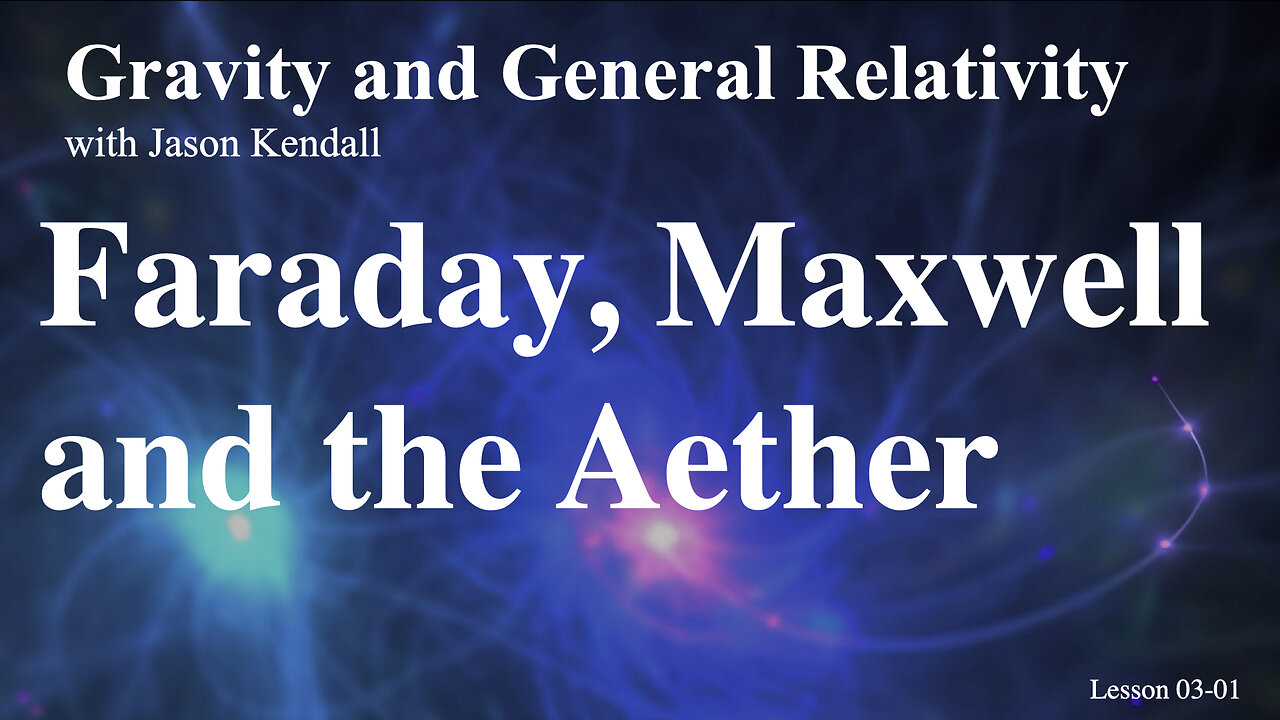Premium Only Content

The Nature of Light: From Faraday’s Induction to Maxwell’s Equations
In this lecture, we continue our exploration of the nature of light, focusing on the historical developments that have shaped our understanding of this fundamental phenomenon. The wave theory of light emerged as the dominant paradigm in the 19th century, and our inquiry will lead us to examine the propagation of light and its relationship with electric and magnetic fields. We will delve into the groundbreaking work of Michael Faraday and James Clerk Maxwell, whose contributions fundamentally transformed the field of electromagnetism and provided profound insights into the nature of light itself. The journey begins with Michael Faraday, a pioneering experimentalist whose investigations in the early 19th century laid the groundwork for modern electromagnetism. In 1831, Faraday discovered that moving a magnet across a wire induces an electric current. This phenomenon, known as electromagnetic induction, demonstrated that a changing magnetic field could create an electric field, thus establishing a connection between electricity and magnetism. Faraday’s experiments, characterized by his hands-on approach and keen observational skills, led him to propose the concept of electromotive force, which describes the voltage generated by this process. Despite his lack of formal mathematical training, Faraday’s intuitive grasp of physical concepts allowed him to visualize the interactions between electric and magnetic fields. By 1845, he had established that polarized light could be rotated by a magnetic field. This remarkable discovery, known as Faraday rotation, suggested an intricate relationship between light, electric fields, and magnetic fields. Faraday posited that light is not merely a wave traveling through a medium but rather a disturbance in the field lines created by electric and magnetic sources. Faraday’s field lines provided a powerful visual tool for understanding the behavior of electric and magnetic fields. He proposed that these fields emanate from their respective sources and exert influence on distant objects without requiring a physical medium. The notion that light is a vibration of field lines revolutionized our understanding of light propagation, allowing scientists to conceptualize light as a wave exhibiting properties such as wavelength and amplitude. In the realm of electromagnetism, Faraday’s visualizations were instrumental, but it was James Clerk Maxwell who provided the mathematical framework necessary to unify these concepts. In 1864, Maxwell published a set of equations that synthesized Faraday’s induction law, Gauss’s laws for electric and magnetic fields, and Ampère’s law into four coherent equations governing electromagnetism. This monumental achievement established the foundation for classical electromagnetism and linked electric fields, magnetic fields, and currents in a mathematically rigorous manner. Maxwell’s equations revealed that electromagnetic waves propagate at a constant speed, which he found to be astonishingly close to the speed of light. By relating the permeability and permittivity of free space—constants that describe how electric and magnetic fields interact—Maxwell demonstrated that light itself is an electromagnetic wave. This groundbreaking conclusion unified the fields of optics and electromagnetism, fundamentally altering our understanding of light. The implications of Maxwell’s work extended beyond theoretical physics; they laid the groundwork for numerous technological advancements. His equations allowed scientists to derive wave solutions, demonstrating that electromagnetic waves could exist across a spectrum of wavelengths. This insight paved the way for the discovery of various forms of electromagnetic radiation, including infrared light, radio waves, X-rays, and gamma rays. Notably, the concept of light as an electromagnetic wave prompted a reevaluation of the nature of light itself. The discovery of infrared radiation by Sir William Herschel in 1800 exemplified that there are wavelengths beyond the visible spectrum. Similarly, Heinrich Hertz’s work in the late 19th century led to the discovery of radio waves, while Wilhelm Röntgen’s discovery of X-rays in 1895 opened new frontiers in both science and medicine. As these discoveries unfolded, a pressing question emerged: what medium does light traverse? During the latter part of the 19th century, scientists speculated about the existence of a hypothetical medium known as the ether, which was thought to permeate space and serve as the medium through which light propagated. This concept, however, would soon be challenged by further experimental evidence. The search for the ether culminated in the famous Michelson-Morley experiment of 1887, which aimed to detect the Earth’s motion through the ether. The experiment produced null results, suggesting that no such medium existed and casting doubt on the ether theory. This pivotal moment in the history of physics set the stage for Albert Einstein’s revolutionary theories of relativity, which ultimately redefined our understanding of space, time, and light. In conclusion, the exploration of light’s nature has been shaped by the contributions of key figures such as Michael Faraday and James Clerk Maxwell. Faraday’s experimental discoveries and visualizations of electric and magnetic fields laid the foundation for our understanding of electromagnetism, while Maxwell’s equations unified these concepts and revealed light as an electromagnetic wave. As we continue to delve into the mysteries of light, we recognize the profound impact of these historical developments on modern physics and technology.
-
 7:20:22
7:20:22
Dr Disrespect
11 hours ago🔴LIVE - DR DISRESPECT - TRIPLE THREAT CHALLENGE - WINNING AT EVERYTHING
196K12 -
 2:35:33
2:35:33
Chrono
4 hours agoBirthday-eve Stream | Helldivers II
7.02K -
 54:40
54:40
BonginoReport
1 day agoLABOR DAY SPECIAL! The Best of Nightly Scroll - Nightly Scroll w/ Hayley Caronia (Ep.124)
93.5K13 -
 LIVE
LIVE
Joker Effect
2 hours agoReviewing the downfall of Kick Streaming. Kick streamers welcome to Rumble! Stake bombshell found!
538 watching -
 1:06:10
1:06:10
Russell Brand
11 hours agoThe Greatest Lie Ever Told? - SF625
78.8K106 -
 3:25:13
3:25:13
elwolfpr
4 hours agoBlack Ops 6: Rise of the Relentless
7.62K1 -
 LIVE
LIVE
Phyxicx
2 hours agoChillin - For The King - 9/1/2025
19 watching -
 LIVE
LIVE
Spartan
8 hours agoNew Game+ on E33, then back to Halo Grind
73 watching -
 7:12:18
7:12:18
GrimmHollywood
8 hours ago🔴LIVE • GRIMM HOLLYWOOD • SKATE EARLY ACCESS • BRRRAP PACK • READY OR NOT •
17.4K2 -
 3:08:11
3:08:11
SavageJayGatsby
6 hours agoLet's Play: Pacific Drive || $300 Weekly Goal - Spicy Bite Saturday || Teen Drinkin is Very Bad
14.7K